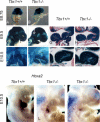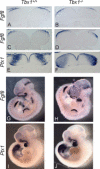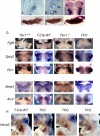Mesodermal Tbx1 is required for patterning the proximal mandible in mice
- PMID: 20501333
- PMCID: PMC2917794
- DOI: 10.1016/j.ydbio.2010.05.496
Mesodermal Tbx1 is required for patterning the proximal mandible in mice
Abstract
Defects in the lower jaw, or mandible, occur commonly either as isolated malformations or in association with genetic syndromes. Understanding its formation and genetic pathways required for shaping its structure in mammalian model organisms will shed light into the pathogenesis of malformations in humans. The lower jaw is derived from the mandibular process of the first pharyngeal arch (MdPA1) during embryogenesis. Integral to the development of the mandible is the signaling interplay between Fgf8 and Bmp4 in the rostral ectoderm and their downstream effector genes in the underlying neural crest derived mesenchyme. The non-neural crest MdPA1 core mesoderm is needed to form muscles of mastication, but its role in patterning the mandible is unknown. Here, we show that mesoderm specific deletion of Tbx1, a T-box transcription factor and gene for velo-cardio-facial/DiGeorge syndrome, results in defects in formation of the proximal mandible by shifting expression of Fgf8, Bmp4 and their downstream effector genes in mouse embryos at E10.5. This occurs without significant changes in cell proliferation or apoptosis at the same stage. Our results elucidate a new function for the non-neural crest core mesoderm and specifically, mesodermal Tbx1, in shaping the lower jaw.
Copyright 2010 Elsevier Inc. All rights reserved.
Figures











References
-
- Ahlgren SC, Bronner-Fraser M. Inhibition of sonic hedgehog signaling in vivo results in craniofacial neural crest cell death. Curr Biol. 1999;9:1304–1314. - PubMed
-
- Alappat SR, Zhang Z, Suzuki K, Zhang X, Liu H, Jiang R, Yamada G, Chen Y. The cellular and molecular etiology of the cleft secondary palate in Fgf10 mutant mice. Dev Biol. 2005;277:102–113. - PubMed
-
- Arnold JS, Werling U, Braunstein EM, Liao J, Nowotschin S, Edelmann W, Hebert JM, Morrow BE. Inactivation of Tbx1 in the pharyngeal endoderm results in 22q11DS malformations. Development. 2006;133:977–987. - PubMed
-
- Beresford WA. Schemes of zonation in the mandibular condyle. Am J Orthod. 1975;68:189–195. - PubMed
-
- Beverdam A, Brouwer A, Reijnen M, Korving J, Meijlink F. Severe nasal clefting and abnormal embryonic apoptosis in Alx3/Alx4 double mutant mice. Development. 2001;128:3975–3986. - PubMed
Publication types
MeSH terms
Substances
Grants and funding
LinkOut - more resources
Full Text Sources
Molecular Biology Databases

